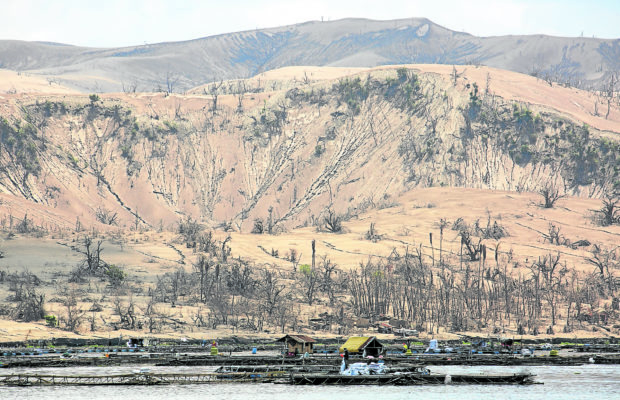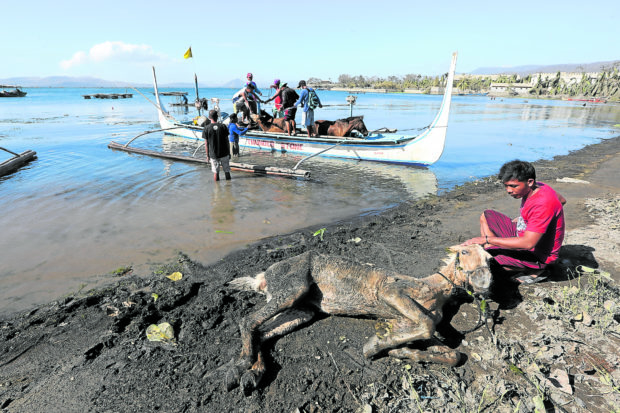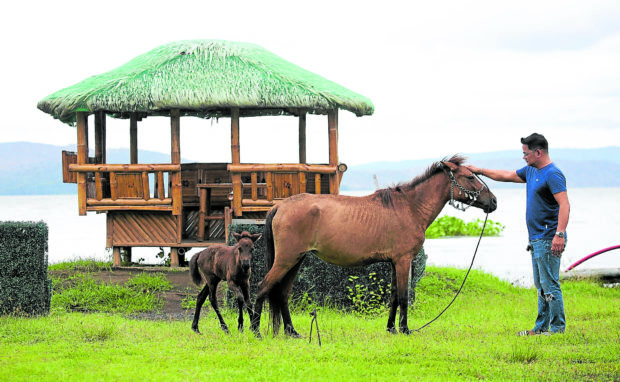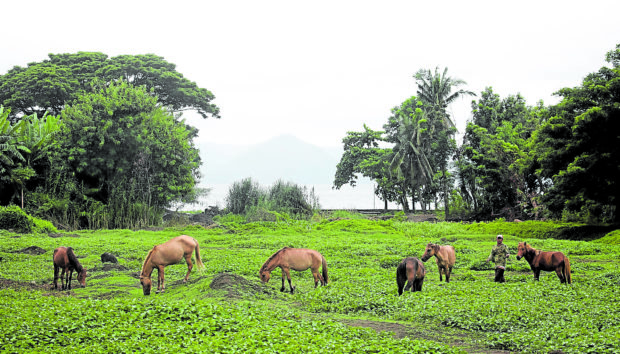Saving Taal’s island horses
BALETE, Batangas, Philippines — It was with a heavy heart that Luisa Silva, 41, sold her third pony last week.
It was a difficult decision to part with her pony — once used for horseback riding activities for tourists who frequented the Taal Volcano Island, or Pulo — to a farm owner who wanted a horse-drawn carriage for his produce.
But Silva needed the money badly, hoping that the P20,000 she got for her young horse would stretch long enough through the new coronavirus disease pandemic, as her family of four—her husband, a teenage son and a year-old daughter—struggled to rethink their lives in a makeshift tent at a resettlement area in the town of Balete, some 60 kilometers or about an hour by boat from their abandoned home on Pulo.
“I hope I wouldn’t have to sell Patricia, [too],” she said, referring to an 8-year-old mare and the last of her horses.
“She is a souvenir,” said Silva of those years when they operated a horseback riding business for tourists on Pulo.
Article continues after this advertisementPatricia is now being kept in a farm in another town where Luisa’s husband works as a caretaker, since horses are not allowed at the resettlement site.
Article continues after this advertisement
DANGER ZONE Taal Volcano Island in Batangas province, Pulo to communities that once thrived there, has been declared a permanent danger zone by the government. Many island residents displaced by Taal’s eruption in January used to earn a living by renting out horses to tourists. —NIÑO JESUS ORBETA
Danger zone
With the government’s sights trained on tackling the impact of the pandemic and the decreased volcanic activities since Taal Volcano erupted in January, people began returning to Pulo but only to fish in the waters around it.
Silva’s house and vegetable plot on the Volcano Island were most likely still buried deep in tons of ash that had left Pulo bare and gray.
Following the eruption, the government has banned human settlement on Pulo, now a permanent danger zone, and shut down tourism and horseback riding activities that propped up the local economy for the last 20 years.
The Silvas used to own seven horses, but they lost three when they and thousands of families fled Pulo in haste, away from the raging volcano.
Without property titles on Pulo, families on the island considered their horses and fishing boats their prized possessions.
Silva said her family used to earn P500 to P750 from every tourist riding the horse on the uphill, scorching trail of Taal Volcano Island. A horse typically did three trips a day.
Without the tours, the horses are practically useless to its owners.
The number of horses on Pulo varied, but ostlers, veterinarians and local officials said they were between 1,500 and 2,000. It was believed to be the largest group of Philippine ponies raised in backyards and decimated by a single disaster.
The island horses were never registered in public veterinary offices, unlike the imported thoroughbred or racehorses that required papers for transport.
Unlike cattle and hogs, horses are not covered by government indemnity programs.
Animal evacuation
The eruption did not only displace people but also forced authorities to move horses and domestic animals, whose sheer number made it a “daunting” task, said Anna Cabrera, executive director of the Philippine Animal Welfare Society (PAWS).
The group, before the Taal eruption, was tapped only to find new homes for cats and dogs.
It underscored the lack of government provision for large animal transport. “The approach of the government when it comes to large animals or livestock is to abandon them and [funds, if any] are simply for ‘restocking,’ or to pay off the farmers for their losses,” Cabrera said.
PAWS has long been pushing the government to include animals in the national disaster preparedness plan.
In Lipa City, veterinarian Samuel Comia said the city government planned to build a permanent animal shelter.
Equine doctors were careful about moving the island horses to mainland Batangas to prevent an outbreak of equine infectious anemia, a viral horse disease, that threatened private stables. Batangas hosts about 90 percent of the population of expensive racehorses in the country.
There were efforts by animal groups and equestrians to rescue the horses left on Pulo but the only well-coordinated mission was done by PAWS and the Philippine College of Equine Practitioners, led by veterinarian Romy Modomo, who brought the horses to Balete.
Although there were some residents who, in defiance of government orders, sneaked into the island to retrieve their horses, playing a game of cat and mouse with the Philippine Coast Guard tasked with ensuring that Pulo would remain uninhabited.

RESCUE MISSION In this photo taken on Jan. 16, ash-covered horses, most of them suffering from burns, are rescued by residents from Pulo a few days after Taal Volcano’s steam-driven eruption. —NIÑO JESUS ORBETA
Safe from slaughter
From Balete, the horses had to be moved out of the danger zone and PAWS successfully pushed the Department of Agriculture to set up a rescue center at its compound in Lipa.
Comia said 55 horses, 14 cattle, five goats and a pig were treated there for shock, dehydration, ash burns and respiratory diseases for a month.
Private farms in Malvar town and Tanauan City, both in Batangas, and in Alfonso town and Tagaytay City, both in Cavite province, also sheltered some horses. But the survivors were “not even close” to the number of animals that died, said equine veterinarian Jay Tolentino.
At the Lipa center, a horse died of pneumonia, but another gave birth to a foal named “Starla,” after a unicorn from a popular children’s show.
It was also a race to save the horses, some of whom came in very bad shape, from butchers preying on owners who just lost everything, said Tolentino.
At one point, Tolentino said he told horse owners selling off their animals: “If you were only to sell them to the slaughterhouse, then let’s stop all these treatment.”
Meat traders
Some of the horses, like “Kiko” who had to be dug up from the ash, were badly injured and could not be ridden on ever again, making them prey to horse meat dealers.
Cabrera said horse meat buyers went to Batangas offering cash, from P3,500 to P12,000, per horse.
To counter the deal, PAWS, through donors, bought 43 horses at P15,000 each. Tolentino also convinced a farm owner in the town of Maragondon in Cavite to buy seven horses.
In the lakeshore village of Ambulong, in Tanauan City, businessmen and members of the Rotary Club bought 28 horses from a group of Pulo residents and farmers, who rescued the animals from Talisay town.
“[The people] were being shortchanged by the butchers, offering them P3,000, some even as low as P2,500 [for a horse]. They didn’t really have much of a choice then because their families were in the evacuation centers and they needed money for their children’s diapers and milk,” said businessman Sherwin Mendoza.
Mendoza said the horses were in the worst condition, “some couldn’t walk anymore or had wounds all over that had [started to produce] pus.” The farmers told him they could not take care of the horses anymore or did not have a place to keep them.
The horse owners offered to sell the animals for P10,000, but Mendoza bought 11 for P12,000 each. He also asked his friends to buy horses.

NEW HOME Sherwin Mendoza’s farm in Tanauan City is the new home of 11 horses rescued from Taal Volcano Island. —LYN RILLON
New lease on life
He said the animals had survived, one of whom already gave birth in his farm in Tanauan.
“I’m really not into horses but I just wanted to help,” Mendoza said. “I also told the owners that if ever they needed their horse, say to carry loads [of coconuts or wood], they could come and borrow the animals.”
Since people could not return to the Pulo anymore, Mendoza plans to open his farm with a lakeshore view of the volcano to tourists and offer horseback riding.
In March, the PAWS horses were adopted by wealthy farm owners and animal advocates, among them business tycoon Fernando Zobel de Ayala and celebrity couple Jun Sunga and Vanessa Matsunaga.
Others ended up in an ecofarm in Zambales province, while the last ones to leave the Lipa center were adopted by model Joey Mead King.
The horses underwent a wellness program that included deworming and dental floating. At least five horses had already given birth in the farms, meaning they were pregnant at the time of the eruption.
Cabrera said the horses were better off in their new homes, their conditions a far cry from the emaciated animals caked in volcanic ash when they stepped off rescue boats eight months ago.
